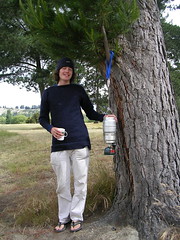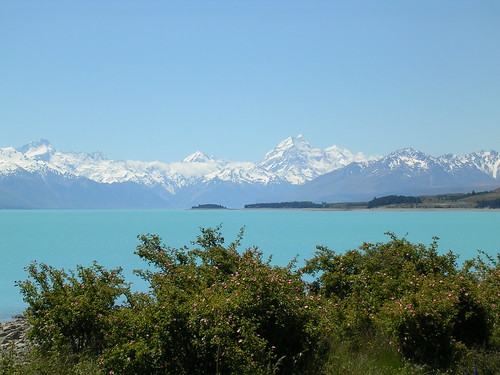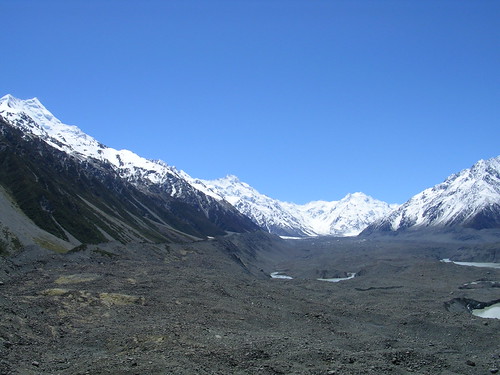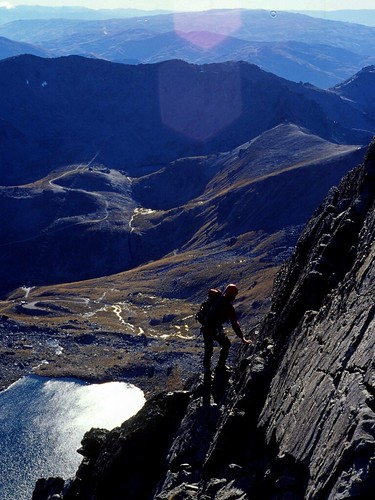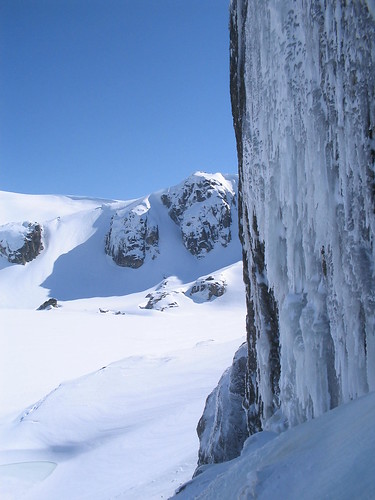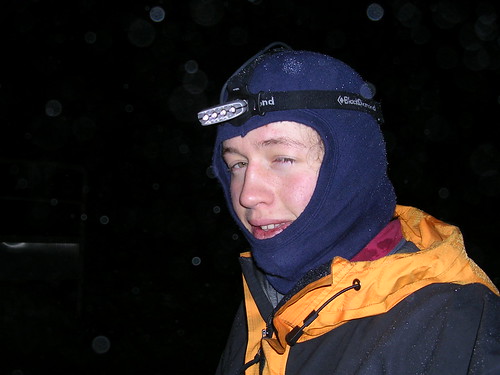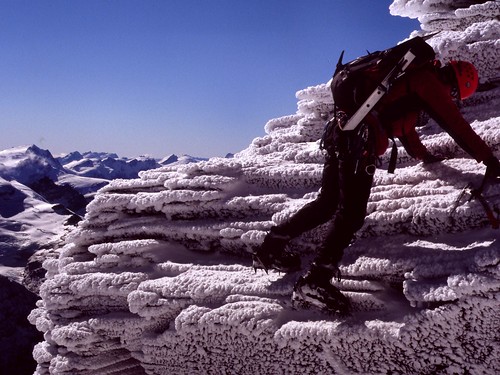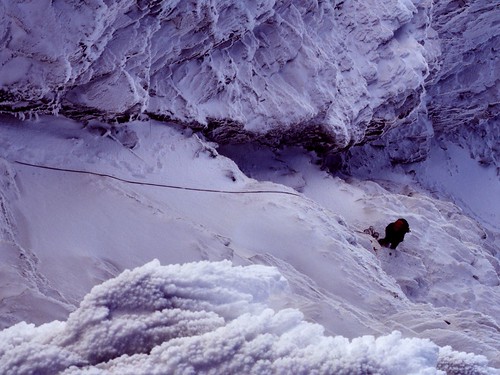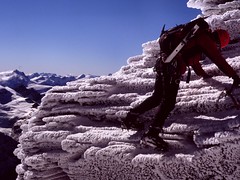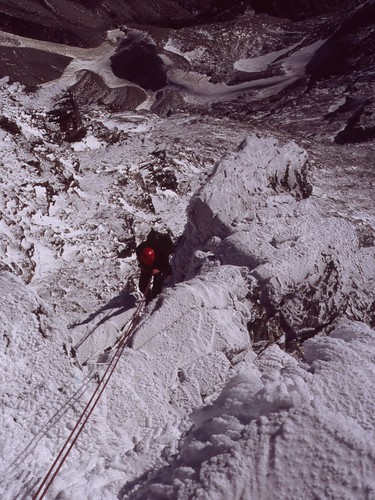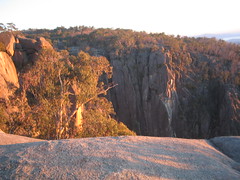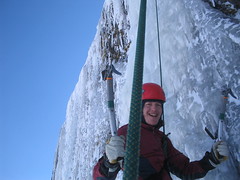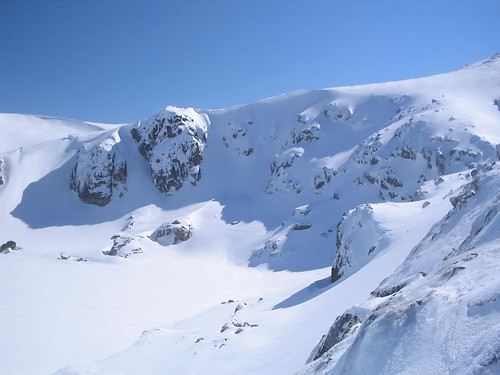I met a traveler from an antique land
Who said: Two vast and trunkless legs of stone
Stand in the desert. Near them, on the sand,
Half sunk, a shattered visage lies, whose frown,
And wrinkled lip, and sneer of cold command,
Tell that its sculptor well those passions read,
Which yet survive, stamped on these lifeless things,
The hand that mocked them, and the heart that fed,
And on the pedestal these words appear:
"My name is Ozymandias, King of Kings:
Look upon my works, ye Mighty, and despair!"
Nothing beside remains. Round the decay
Of that colossal wreck, boundless and bare
The lone and level sands stretch far away.
-Percy Bysshe Shelley
1792-1822
Ozymandias; what can I say. It is The big Aid climb to do in Australia. We don't have anything really big, but if you want to learn in preparation for Yosemite, or if you just want the Australian Aid experience > then you had better get on Ozy!!!
Finding beta on Ozy isn't too hard, but I haven't seen a good online article, so I thought I would put up some info based on my own experiences. I climbed Ozymandias in between 7-9th of May, 2005. I was 17 and it was my first "bigwall", also my first time up the north wall at Mt Buffalo. This isn't inteded to explain the technicalities of leading/hauling and other big wall shenanigans, only to give some ozy specific beta.
Preparation:
Ozymandias gets a grade of M4 which is about A2/A2+. If you are stronger than me you could climb some of it free, and this woud speed you up a bit. Don't let the high free grade fool you though; you can aid all but the first pitch, which is maybe grade 16/17 at the most. This climb is not out of reach for a strong trad/adventure climber who is willing to put the time in to learn how to aid climb. In terms of aid practice, we did a few laps on a local aid climb in Canberra "Vertigo" It is about 30m of M4. I would also advise practising aiding up steep hand crack and such, as some of the pitches are easier "cam jugging" and being practised at this could really speed you up.
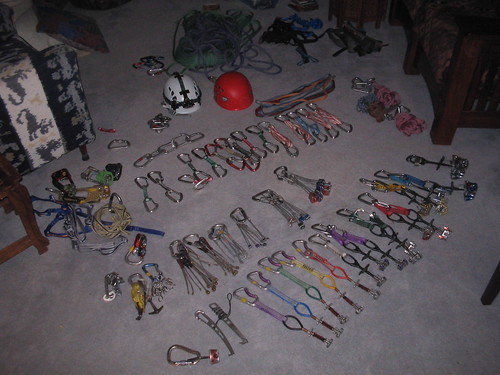
Equipment:
We took a fairly large rack for Ozy, I guess it depends how much backcleaning you want to do. One thing: Ozy goes clean!
Do not take a hammer on this climb, it is now one of the best free routes in the country, as well as being a killer aid route; DO NOT ruin it for others by taking pins and damaging the rock; if you want to nail, there are some harder routes at Buffalo where this is accepted. Ozy is a clean aid climb!
Personal Gear:
Harness, helmet, headtorch, shoes. etc
one set aiders each (or one set for the leader + a set of sling steps for the second to jug with)
2 x daisy chains (we took 3 and swapped around, but you may as well have 2 each)
one set of ascenders each (maybe you could take one set between you if your doing it in a day and swinging leads)
Rack:
One 'burly' 60m lead line
One 60m haul/tag line
Aliens 1 - 5
Single Camalot # .4
Double Set camalots 0.5 - 3 (or equivilant freinds)
Camalot 4 + 5
3 sets small wires (we took 2 xsets RP's, one set small BD nuts > lots of people recommend DMM peenuts for the pinscars)
double set normal wires (we took 2x 4-13 BD stoppers)
couple of skyhooks (we had one BD talon + one BD cliffhanger)
10 bolt plates
cinch hangers (for the dodgier carrots > if you can find them)
a bunch of hero loops (short loops of tape for tying off fixed gear)
5 "trad" (extendable) quickdraws + a bunch of shoulder slings
10 normal draws
about 15? spare biners
2 x Anchor kits > we built separate power points for fixed line, and haul line. this means two cordelettes per anchor plus associated biners and lockers. Oh and if you can get one, take a wall hauler (eg petzl mini traxion)
Overnight Gear: (each)
Sleeping bag (synthetic) + bivy bag + plus sleeping mat (NOT thermarest > they pop)
Rain gear/warm clothes
At least 3 litres of water per person per day!
Food for however long you're up there, suggestions:
brekkie: instant oats/protein bars/muesli bars etc
lunch:take things you can eat out of your pockets eg, muesli bars/energy gels?/nuts/dried fruit/mini cheeses/ salami
dinner: instant meals (if you take a stove)/tiined chili beans + tortillas/tinned fish/biscuits+cheese/couscous+tofu
Remember tinned foods are great wall food as you need the water anyway!
Poop Tube: all the above comes out the other end. DO NOT SHIT ON BIG GRASSY : PACK IT OUT! we took plastic bags and them put them in screw top tubs (1 litre capacity each sufficed for 2 days) take a pee bottle too: pack it out!
Haul bag to take all this crap in!
Access & Retreat (courtesy of Anthony Morgan)
• Park at the Oval Picnic Area. Walk across the oval to join the Gorge Heritage Trail and follow to the left
• Follow the trail across the bridge and along the top of the North Wall. Take note of the loop trail going off to the left just before the bridge. Don’t mistakenly take this on the way out in your big wall drowsiness or after dark
• At the second Heritage Sign, which displays an old photograph of a vintage car and lady passenger, turn right and follow faint track to the cliff edge. Turn left along the cliff edge to a large boulder perched on a sloping ramp. Abseil anchors can be found on the outside of the boulder
• 60 metre ropes are required for the abseils (53m longest rap)
• First abseil - chains were extended with a sling to ensure ropes didn’t get stuck
• Second abseil pitch is long and requires a small swing to the left (FO) to the next anchor bolts. Be wary of the flake above left when pulling down the ropes
• Third abseil pitch to Comet Ramp. Scramble up small rise and then two scrambling abseils to the base of the climb. From here it is about a 10-minute walk to fill water bottles
If you are in the unfortunate position of having to retreat back to the base of the climb, the following is the way to walk out. Go down to the creek from where you fetched the water. Look carefully for a rock cairn when crossing the creek, and then continue to follow these cairns. They are not always frequent or obvious to see, a fair amount of crushed vegetation is encountered though. Continue to follow the cairns across another creek then up steeply for some way. Not too far from the base of Where Angels Fear to Tread you will come to the base of a small wall which angles upwards to the right. Do not trend right up this large ramp, but go a short distance to the left where you should find a knotted length of rope to go up (awkward). Don’t be tempted to turn right near this rope. You are heading for the base of ‘Where Angels Tear to tread’. Once at the base of this climb the track becomes more distinct, this will take you to the hang glider ramp. 3 hours.
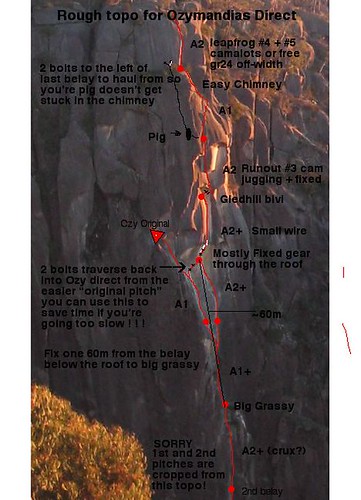
Tactics:
Most people doing Ozy for their first time do it in 2-3 days. Strong parties could do it in a day. I have not yet done it in a day so I will not offer advice on that, and anyway if you're planning it in a day, you must already know more than me.
3 days: you must be confident climbing/cleaning/hauling 3-4 aid pitches a day!
Day 1: You need to get to big grassy : sleep on big grassy
day 2: you need to fix your lead and haul line to the gledhill bivi, then rap down and sleep on big grassy
day 3: jug back up and push through to the top > well done!
2 days: you need to be confident climbing about 5 pitches a day of aid.
day 1: preferably you want to fix from big grassy to the belay below the roof pitch: sleep on big grassy
day 2: jug the fixed lines then finish the climb.
Pitch by Pitch descriptions courtesy of Anthony Morgan
Pitch 1 to 5
Pitch 1: A1 Corner, 24m
• Start at two aid bolts on the blank wall. Free over into the Ramp and steepening Corner with its perfect A1 crack. Up to belay on a large flake ledge with 3 bolts
• Nuts, aliens and cams to #3
Pitch 2: A2+ Corner, 34m
• Technical aiding up the thin corner using the blown out pin scars to a hanging belay
• Small nuts are excellent in the pin scars, as are aliens and cam hooks. Nuts and cams to #2
Pitch 3: A2+ Corner & sloping bulges, 46m (to #3, hooks)
• Technical aiding up the thin corner through 2 sloping bulges on more blown out pin scars. Hook or traverse left onto a ledge, then leapfrog large cams up to Big Grassy
• Small nuts are excellent in the pin scars, as are aliens and cam hooks. Nuts and cams to #3. One section, 2/3rds up the corner is very thin requiring either a leeper logan hook or carefully placed #2 BD offset nut
Big Grassy Bivy:
• BG has bolt anchors and a good crack in the corner
• Two sleep comfortably
Pitch 4: A2 Corner, 20m
• Technical aiding, up the corner above BG to the yellow roof. Extra gear can be placed in the crack to back-up the belay
• Nuts, aliens and cams to #1
Pitch 5: A1 Superb Corner, 35m
• Move up and right into the Superb Corner. Once below the roof, either go left on an obvious tiptoe ledge to belay at the arete, or right on a bolt ladder to a HBB under the roof pitch of Ozy direct
• The corner takes mainly large wires and aliens, with the occassional cam (to #3 for Ozy original)
Ozy Original Pitch 6 to 9
Pitch 6: A1 Awkward Corner, 45m (to #3.5)
• Good placements but awkward aiding. Up the ramp, into the hanging corner, over the bulge to belay at two bolts and the diagonal crack
• Nuts, aliens, cams to #3.5 and lots of slings. Hooks can be useful for quick placements
Pitch 7: A1 The Traverse, 15m (to #3.5)
• Aid under the tree, then shuffle cam’s (Sizes 2,3,3.5) along the large uniform crack to the chimney
Pitch 8: A1 The Chimney, 29m (Aliens, #1 to #4.5)
• Use two Aliens in pin-holes to get up to the tree. Climb up the tree and into the chimney. Place the #4.5 on your left then chimney up to belay on a ledge
Pitch 9: Scramble, 23m.
• Coil all the ropes, duck under the blocks into the back of the chimney. Ferry gear to the left, scramble up right and then haul straight up the hole. Repeat. Finally crawl through the body squeeze at the back of the chimney and again haul straight up through the bigger gap. Ferry to the lookout
Ozy Direct Pitch 6 to 9
Pitch 6: A2+ The Roof, 30m
• Bolts to the roof, then aid through roof and follow the thin crack to the Gledhill bivvy
• Nuts, aliens, cams to #0.5 and lots of slings
Pitch 7: A1 The Fang, 30m
• Follow bolt ladder to the right. Up ramp to beneath the fang, before moving left into a large, gnarly crack. Shuffle cam’s up crack and over bulge to HBB
• Nuts, aliens, slings and cams to #4.5
Pitch 8: A1 The Chimney, 30m (Aliens, #1 to #4.5)
• Continue shuffling large cams to a bolt. Mantle on to ledge, then scramble up chimney to belay at top
• Large cams. Nuts and a few cams for the belay (#1 to #3)
Pitch 9: A2 or 22 Chimney/offwidth, 28m.
• Up the crack / corner to the tourists at the lookout
• Nuts and large cams to #4.5 (protect the first half with nuts in the crack to the left)
DISCLAIMER: I AM NOT RESPONSIBLE FOR ANYONE WHO TRYS TO CLIMB THIS ROUTE AND HAS AN EPIC. CLIMBING IS ABOUT TAKING RESPONSIBILITY FOR YOUR OWN ACTIONS: THIS IS A SERIOUS ROUTE FOR EXPERIENCED CLIMBERS, YOU MUST BE ABLE TO ASSESS YOUR OWN ABILITY IN RELATION TO THIS CLIMB, THIS ARTICLE ONLY OFFERS TIPS TO THOSE WILLING TO ACCEPT THE POSSIBLE CONSEQUENSES OF FUCKING UP ON THIS CLIMB; CLIMBING CAN KILL YOU: TAKE CARE!
If you need any more information please email me max.fourman@netspeed.com.au
